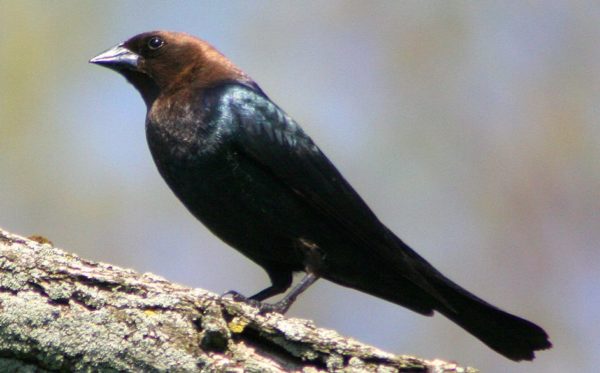Information About The Bird
Seen/Heard at
Decorah, Decorah North
Diet
Brown-Headed Cowbirds are primarily ground foragers often observed near livestock (hence the name ‘cowbird’). Grass and weed seeds make up about 75% of their diet. The other 25% consists of insects, snail shells, and eggs removed from parasitized nests. Female cowbirds need to replace the calcium lost to laying eggs, so they expand the insect and shell components of their diet during breeding season.
Nesting
Cowbirds are brood parasites. Instead of building their own nests, they lay eggs in the nests of other birds of more than 220 species of birds. Female cowbirds find nests in three ways (Norman and Robertson 1975): they perch quietly in the tops of shrubs or trees and silently watch for nest-building activity in surrounding open areas; they walk on the ground, looking about and watching movements of other birds; or they noisily search vegetation in an attempt to flush out possible hosts. Female cowbirds lay one to seven white to grayish-white brown or grey spotted eggs in the nests of other birds, often choosing birds with two or more slightly smaller eggs in the nest. They often consume at least some of the eggs they are replacing. Cowbird eggs need 10-12 days of incubation and nestlings stay in the nest for 8-13 days. To learn more, visit Cornell’s website.
So how does a Brown-headed Cowbird, raised by parents of a different species, learn to sing the correct song? The “chatter call” of an adult cowbird triggers something in a fledgling’s brain that guides it to recognize its own species, even though cowbirds are fostered by as many as 220 different species! (https://www.birdnote.org/show/cowbird-song-and-password)
Genetic analyses show that most individual females specialize in a host species. In much the same way that birds can imprint on humans, perhaps they were raised by that species and see them as appropriate parents for their young.
Citations
Bird Range Maps of North America
Ridgely, R.S., T.F. Allnutt, T. Brooks, D.K. McNicol, D.W. Mehlman, B.E. Young, and J.R. Zook. 2003.
Digital Distribution Maps of the Birds of the Western Hemisphere, version 1.0. NatureServe, Arlington, Virginia, USA. Data provided by NatureServe in collaboration with Robert Ridgely, James Zook, The Nature Conservancy – Migratory Bird Program, Conservation International – CABS, World Wildlife Fund – US, and Environment Canada – WILDSPACE.
Web Link: http://bit.ly/2ynPQ5I
The Cornell Lab of Ornithology Birds of North America: https://birdsna.org/Species-Account/bna/species/bnhcow/
General Description
Male Brown-headed Cowbirds have glossy black plumage and a brown head that may look black in poor lighting or at distance. Female Brown-headed Cowbirds are brown, lightest on the head and underparts, with fine streaking on the belly and a dark eye. Males and females alike have short, black, thick beaks that more closely resemble a finch’s beak than a blackbird’s beak. Females are slightly smaller than males
Migration
Brown-headed Cowbirds are short-distance diurnal migrants. They spend the summer in the Decorah area before migrating 400 – 500 miles south. They breed from early April to late August, departing for their wintering grounds between the middle of August and the end of October. They often migrate in mixed flocks with Red-winged Blackbirds, Common Grackles, and European Starlings.
Measurements
Male
Length: 7.5-8.7 in/19-22 cm
Wingspan: 14.2 in/36 cm
Weight: 1.5-1.8 oz/42-50 g
Female
Length: 7.5-7.9 in/16-20 cm
Wingspan: 15.0-12.6 in/38-32 cm
Weight: 1.3-1.6 oz/38-45 g
Wing Design
Pointed. Optimized for bursts of fast, tightly controlled flight. Excellent at taking off quickly, maneuvering through branches, and avoiding predators.
Video: Male and female Brown-headed Cowbird
| See also different: | Blackbirds, Decorah Nest, Decorah North Nest |
